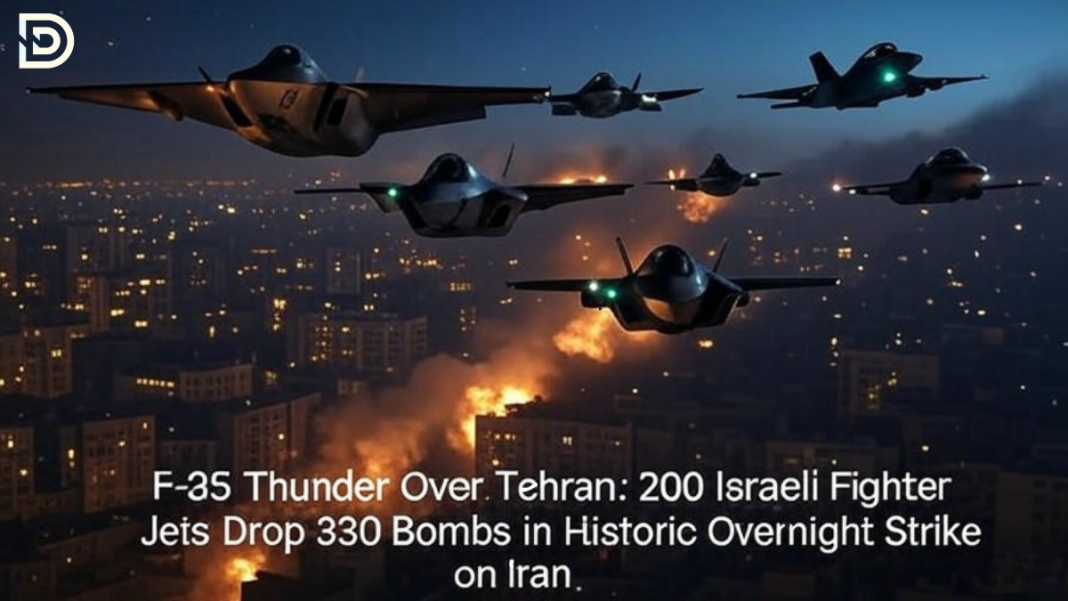In a strike operation that military analysts are already calling the largest single combat sortie in Israeli history, the Israel Defense Forces (IDF) confirmed that 200 warplanes—a staggering 60% of the nation’s combat fleet—took to the skies in the early hours of Friday to execute precision strikes deep inside Iranian territory.
This massive aerial assault, codenamed Operation Rising Lion, targeted Iran’s nuclear infrastructure, elite military compounds, and senior command nodes in a sweeping show of force that has left the world stunned and regional adversaries reeling.
What makes this operation unprecedented is not just its scale—but the machinery behind it.
🛩️ Fury in the Skies: U.S.-Built Warplanes Dominate the Israeli Arsenal
Imagery released Friday by the IDF’s spokesperson unit showcased three of the most lethal warplanes in modern air combat history—the F-35 Lightning II, the F-15 Eagle, and the F-16 Fighting Falcon—all of which played a central role in Israel’s dramatic overnight assault.
Each jet, manufactured by U.S. defense giants Lockheed Martin and Boeing, reflects the depth of Israel’s strategic partnership with the United States and its reliance on American firepower for deterrence and preemptive dominance.
“This wasn’t just an airstrike—it was a full-spectrum projection of fifth-generation warfare,” said one NATO airpower strategist.
“This level of integration, scale, and execution is rarely seen outside of major wars.”
🔥 Operation Rising Lion: What We Know
-
200 fighter jets participated in the operation, representing nearly 60% of Israel’s total combat-capable aircraft, per the latest Military Balance 2025 report from the International Institute for Strategic Studies (IISS).
-
The jets dropped a total of 330 precision-guided munitions on Iranian nuclear enrichment sites, ballistic missile bases, and elite military command centers in cities such as Tehran, Natanz, Khandab, and Khorramabad.
-
Targets included both above-ground and hardened underground facilities, many believed to be central to Iran’s fast-expanding uranium enrichment and missile delivery systems.
The Day Stealth Died: Iran Becomes First Country to Destroy F-35 Jets in Active Combat
🕵️♂️ Aircraft Breakdown: Israel’s Triad of Air Superiority
F-35I “Adir” Stealth Fighters
-
Israel operates 39 F-35 I jets, a customized version of Lockheed Martin’s F-35A.
-
These fifth-generation fighters offer stealth capabilities, electronic warfare systems, and networked combat integration.
-
Their low radar signature allowed them to penetrate Iranian airspace undetected, delivering the first wave of bunker-buster munitions.
F-15 Eagles
-
Israel owns around 75 F-15s across multiple variants.
-
Known for their high speed and heavy payload, F-15s are ideal for follow-up strikes, air superiority, and long-range interdiction.
-
Used in Operation Rising Lion for deep penetration support and secondary wave munitions deployment.
F-16 Fighting Falcons
-
With nearly 200 F-16s, Israel holds one of the largest fleets of these versatile multi-role jets outside the U.S.
-
Used extensively for precision bombing, target painting, and defensive air patrols during the operation.
-
Responsible for mid-air refueling support and electronic countermeasures during the withdrawal phase.
🇺🇸 U.S.–Israel Defense Nexus on Full Display
The operation has also reignited global focus on the military-industrial alliance between Washington and Tel Aviv. The entire Israeli combat fleet is composed of American-made platforms, supported by joint intelligence operations, software upgrades, and advanced munitions supplies.
“From Lockheed Martin’s stealth engineering to Boeing’s payload capacity, this was a showcase of American airpower through Israeli hands,” said a former Pentagon defense official.
The strategic partnership extends beyond aircraft—into missile defense (Iron Dome, Arrow), satellite intelligence, and cyber defense cooperation. This operation has made it abundantly clear: Israel’s air dominance is American-enabled and battlefield-proven.
Iran Hits Back Hard: Zolfaghar Missiles, Shahed Drones Pound Israeli Targets After Air Strikes
📈 Military and Diplomatic Shockwaves
The impact of this display of airpower is not limited to the battlefield.
-
Iran’s Supreme National Security Council has activated full-scale emergency powers.
-
Israel has placed its population on maximum alert for retaliation—missiles, drones, or cyberattacks.
-
Regional players like Saudi Arabia, Turkey, and the UAE are monitoring fallout closely, fearing spillover strikes.
-
Oil markets surged by 11% within hours, and international airlines rerouted dozens of flights to avoid potential air conflict zones.

